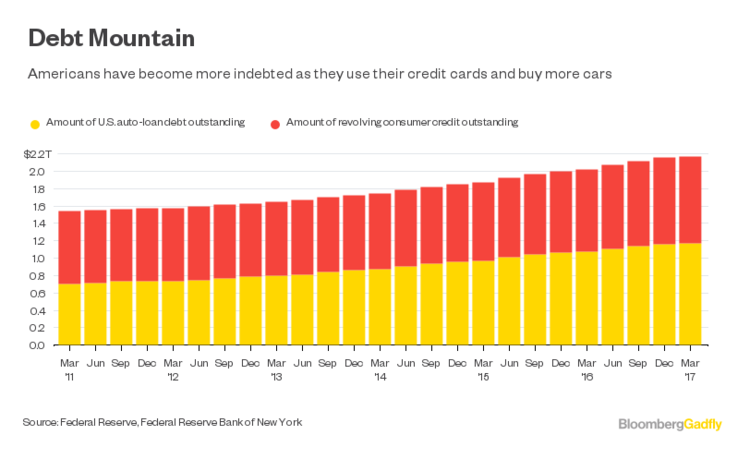It's unsettling that a growing number of Americans arefalling behind on their auto-loan and credit-card bills.But it's even more unnerving that analysts seem somewhatsurprised by the pace and scope of late payments and losses.Consider private-label credit card company Alliance DataSystems, for example. This week it reported a “dramatic drop”in recovery rates in April, which led research firm Compass Pointto question what the lender “may be doing operationally tocreate so much more volatility in recoveries than its peers,”Bloomberg News reported Tuesday.
|Meanwhile, lenders including Santander Consumer USA and AllyFinancial have been hit by a surprisingly steep deterioration inconsumer creditworthiness. Their share prices haveslumped this year as they set aside more money thanexpected to cover loan losses and update forecasts toinclude deeper declines in used car resale values.
|Capital One and Synchrony recently raised their forecasts fornet credit-card charge-offs in 2017, citing weakness among subprimecustomers rather than their previous rationale of portfolio growthand aging, according to Bloomberg Intelligence.
|All this raises the question: Why didn't these financial firmsand Wall Street analysts better predict that more consumers wouldstruggle with their bills as they packed on debt and gorged onnew cars and trucks? As UBS analysts Matthew Mish and StephenCaprio wrote in a report on Wednesday, “The worse-than-anticipatedperformance in auto lending should raise questions around modelefficacy.”
|It's worrisome to think that big lenders may have failed tosufficiently account for certain borrower behaviors, such asconsumers prioritizing their medical bills before auto loansor maxing out their credit-card debt limits while trying tomeet all their obligations. But there's also the presenceof the type of fraud seen in the last crisis, which is makinga bit of a comeback. The UBS analysts said that as manyas one in five auto-loan borrowers admitted in a recent survey thattheir debt applications contained inaccuracies.
|If the models used by the lenders themselves are flawed andbased on unreliable data, they will fail to adequately warn of evensteeper delinquencies and losses ahead. And this potential blindspot to future losses comes when auto sales areslumping, the economy isn't accelerating rapidlyand household debt is reaching a fresh peak.
|The UBS report highlights that there's quite a bit of overlapbetween consumers who have auto loans and credit-card debt, not tomention mortgage, student and medical obligations. Lenders arerecognizing this, with Santander Consumer USA recently deciding tostop taking payments by credit cards. Financial firms are alsotightening their lending standards, with new car loans for subprimeborrowers falling in the first quarter to the lowest in two years,according to data from the Federal Reserve Bank of NewYork.
|It's hard to see how auto-loan and credit-card defaults willlead to a 2008-style meltdown, but it's fairly easy to see howlosses could build up, especially as banks cut off credit to themost-indebted borrowers. The big automakers are already reportingdeclining sales and layoffs. Meanwhile, American consumers won't beable to spring for new purchases if their credit lines are maxedout. This growing spot of distress will bleed into the economy inmany ways and will eventually slow growth even further.
|
Bloomberg News
|Copyright 2018 Bloomberg. All rightsreserved. This material may not be published, broadcast, rewritten,or redistributed.
Complete your profile to continue reading and get FREE access to Treasury & Risk, part of your ALM digital membership.
Your access to unlimited Treasury & Risk content isn’t changing.
Once you are an ALM digital member, you’ll receive:
- Critical Treasury & Risk information including in-depth analysis of treasury and finance best practices, case studies with corporate innovators, informative newsletters, educational webcasts and videos, and resources from industry leaders.
- Exclusive discounts on ALM and Treasury & Risk events.
- Access to other award-winning ALM websites including PropertyCasualty360.com and Law.com.
*May exclude premium content
Already have an account? Sign In
© 2024 ALM Global, LLC, All Rights Reserved. Request academic re-use from www.copyright.com. All other uses, submit a request to [email protected]. For more information visit Asset & Logo Licensing.







